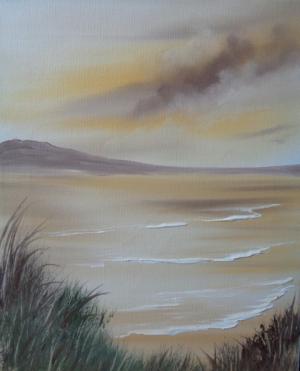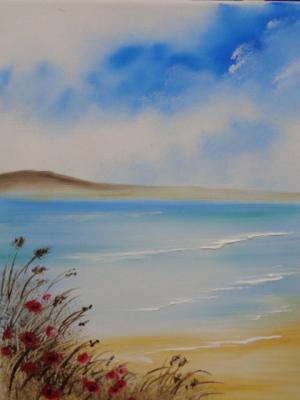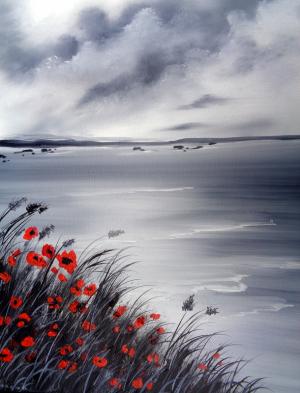How to Guides
How to Sell Your Art Online
One artist's approach
Affordable British Art would like to thank one of our Artists, Peter Williams for writing this very informative and helpful guide.
So you thought you would sit around painting all day and watch the cash roll in?
Think again!
Selling your art successfully, that's a big question and I'm sure there are many, many opinions about it out there. I have been asked several times by people struggling to find ways to sell their art, for tips and advice. I seem to be perceived as a successful artist and, having been living mostly from my income as an artist since 2002 I think that is a success in itself. However I don't consider myself an expert salesperson, if I were I'd be earning a lot more. I live on an extremely tight budget, more or less hand to mouth so what I call successful wouldn't necessarily be the way everyone sees it, but I wouldn't change my life and hopefully things will continue to move onward and upward.
Anyway, here are some ideas, tips and an insight into the way I have gone about getting moderately established which I hope may help others get started.
After initially running around like a headless chicken, going from village fair to village fair, joining one online gallery after another, I found it difficult to keep track of anything. Income was sporadic at best, I had no idea which direction I was going in as an artist and it was a lot of hard and tedious work. Recognise yourself? Read on!
I decided to formulate a plan and take more control of my business life. Yes, selling my art is a business and has to be run as such, regardless of whether it's part time or full time. That means no more giving away paintings cheaply or even for free. No more (or very few) favours for friends or family. After all, if your business was a pub I'm sure friends wouldn't expect to have free drinks each time they called in, (OK some of mine would) so why give away your skill and time as an artist for nothing.
Pricing.Get a grip of your pricing strategy. If you undersell yourself people will assume you are just another hobbyist and not take you seriously. It irritates me to see perfectly reasonable original artwork for sale at just £25 or so. If you don't value your work, why should anyone else? Search out artists of a similar standard to yourself using similar media (who appear to be making regular sales) and get a feel for what is selling at what price. Take into account how established these artists are, whether they are published, have won awards, etc. etc. These things will have a positive effect on what prices they can command and you will be able to allow your own prices to slowly increase over time as you get established yourself. I'm not a believer in pricing myself by the hour or the square inch as some do. Each to their own and of course time and size should be part of the equation but personally I have a core price structure for my work then I take into account previous similar sales, how good I personally think the piece is, where I am going to try to sell it (some venues will be at a premium which I will come on to later) and most important of all, how marketable. So don't be greedy or too modest, place yourself in the market where you think you belong and use that as a starting point.
The Brand.My business is perhaps 80% web based and so what I decided to do was to create my own 'brand' which people would visually recognise as mine and hopefully be catchy and attractive enough for them to remember. A website forms the nucleus of my business and potential customers are going to find me via search engines more than anything else. It's unlikely that they are going to search for me by name as I'm not that famous, rather they are going to be searching for a piece of art and hopefully stumble across my website by chance. So it seemed a good idea for a business title to include a key word or two. As I am fairly well known for Western genre artwork I came up with the name Mighty Fine Art which seems to fit the bill. I checked that a fitting domain name was available (www.MightyFineArt.co.uk) and I bought it, (later, when I discovered you could assign more than one domain name to a website, I also bought www.peterwilliams-art.co.uk). I incorporated this name with one of my paintings which I find particularly pleasing and use this as a logo. My Mighty Fine Art 'brand' was born.
Website.Getting my own website up and running has been the single most important thing I've done. As previously stated, as an artist I don't have much spare cash to throw around so couldn't afford to have a website custom built for me. I also don't have very much knowledge about website building so knew I was going to have to have a go at a DIY site. The first thing I did was to visit and review dozens of other artists' websites to pick out features I like and dislike, forming an idea of how I wanted my website to look and, just as importantly, how I didn't want it to look. Next I looked at a few of the many companies out there offering a DIY website building service with hosting. I decided on Webeden.co.uk . They seemed to offer everything I was looking for at a reasonable price with an in depth accompanying 'help' feature. I won't go into detail but, starting with a basic template I was able to adapt it and build what you now see as the Mighty Fine Art website. I'm happy with it, it does well for me and costs about £55 a year all in. Now MightyFineArt.co.uk is up and running, from now on everything I do is aimed at driving traffic to it.
Driving Traffic to your Website
There are many, many ways of doing this. Here are some:
A Blog:This is a great tool to have linked to your site, a regularly updated blog gets picked up very well by search engines. Uploading new work and any news about exhibitions and shows you are involved with will keep it effective and interesting. Get as many links as possible to the website.
On-line Galleries:Despite studying and implementing all I can find out about Search Engine Optimisation techniques (SEO) I realise I am never going to be able to compete with the big boys. A lot of searches will put me on the first few pages nowadays, but there are a lot of clever people out there who get top rankings all of the time. So for this reason as well as others it's important for me to maintain a presence on several on-line galleries to supplement sales from my own site and maintain a good internet presence. In my opinion a lot of the free sites are next to useless when it comes down to progressing your business. Bear with me, I’m talking about earning from your artwork here which is different to having a pretty portfolio of your work to show your friends but which does nothing in the way of sales.
A key thing to make sure you get near the top of internet searches is to keep all of your on-line galleries refreshed and interesting. Each one you choose to be on will take up some of your time in maintaining it, uploading new work, refining descriptions, altering the status of pieces if sold or reserved etc. etc. So you should choose a number you feel you can cope with and give your best attention to. The worst thing is to get an enquiry about a piece from a site you had forgotten you were on, which has long since sold. That would just damage your reputation as well as lose you a potential customer, and they are tough to find. Therefore it’s important to choose those sites that will work for you rewarding your time and effort and in some cases money. Then exploit them to their full potential. You can't just sit back and wait for orders to roll in, it won't happen.
There are really only 3 types of site to consider.
Free sites (or very cheap) where you can upload your work purely as an on-line catalogue which you can show to your family and friends, join in forums, make contacts etc. but with very little marketing on your behalf by the site owners and very little chance of sales. These are great for becoming part of a community where you might get advice, encouragement ideas and become a little better known by other artists. But they are not your potential customers. Artwanted is in this category and well worth being a member, but you don’t need too many sites like this. Whichever you join make sure you have a link or several links to your website.
Then there are the sites which are free to join and which work hard on promotion and do their best to get sales for you. Then you pay the site a commission of 25% or sometimes as much as 50% on any sales you get. These tend to be worth while being on, someone is working hard on your behalf and they don’t get paid unless you do. So you can trust they will do their best. I've chosen to be on 4 of this type of site but I've set myself a limit of what commission I'll pay of 30%.
Finally, there are the sites where you pay up front to be a member and then any sales you make are completely yours. You have to choose carefully here as it is easy for them to rake in the money and sit back and do very little to promote the site. There are some good ones out there though, but they can be expensive. I choose to be on just one of these sites and if I find it hasn't paid for itself with sales when renewal time comes around, I move on.
So how do you choose which? Firstly, think about your work carefully. How would you best describe it, better still how do you think other people would describe it. Then think about who you want to find your work and what are they likely to type into a search engine to find it. For example in my case ‘original paintings of native American Indians’ I could narrow that down by adding words like ‘affordable’ and ‘watercolour’ Think up a few key phrases like that and type them into search engines. See which on-line gallery sites consistently come up on the first few pages. Any further back and they haven’t done their SEO properly. Make a note of them. Then go through them.
Think like a customer and see how attractive the site is, how easy it is to navigate and find what you are looking for. Very importantly see how well the images are displayed, the descriptions, everything you might look at if you were a buyer. See the quality of the work, you don’t want to be lost in the middle of a million cheap and amateurish pictures.
At the same time you might not want to be competing with the worlds top artists just yet. How big is the site? will your work be swamped and lost?
Are there too few artists on there to attract repeat visitors?
Having selected those sites you like, look at the cost if any of creating a gallery, how large a gallery you get for your money. As a rough guide, the cost of one sale ought to cover it. Before committing, read the T&C carefully, often the proprietors of some of these sites are out to make a fast buck with little regard to the artists so pay attention for instance to anything that allows them copyright of your images. It’s OK if they want to use your images to promote you or the site, but not for commercial gain such as prints etc. where you will lose out.
Online Business Directories are a great tool for getting your website and art noticed. Sites like Hotfrog.co.uk and Freeindex.co.uk are free to register and drive a lot of traffic to my website. There are hundreds of others to review, some you pay for but I haven't felt the need to pay.
Self promotionThis is the next most important thing. Get business cards made up with the details of your website. Get greetings cards done the same. Get these out there at every opportunity. Put links to your website on every email, everywhere you can. Talk to people at craft fairs, exhibitions, down the pub, DON’T LET ANYONE ESCAPE without at least taking a business card. I have magnetic signs made up for my van, mouse mats with my logo etc. There are many other things you can get done to advertise your site such as mugs, key rings etc.
I self published a book of some of my art work via Blurb.com which has sold well. Although very little profit on quite a large outlay I think it was worth doing to promote Mighty Fine Art and raise my profile a notch.
I've taken out a 6 month advert in a glossy magazine this year, relating to my website to try to drum up commissions. We shall see if it pays off. Basically, set a promotions budget each year and be as creative as you can.
Social Networking sites like Facebook and Myspace have potentially a massive audience, so you can use them quite effectively by adding photos of your work and again to drive traffic to your website.
Ebay or Etsy I used to sell quite a lot of paintings via my ebay store but for some reason it seemed to die a death a while back so I closed it. However I still maintain a small presence on there, selling some of the less expensive items occasionally and if I have a studio clearout I sometimes put a few bargains on there. Again, I make sure I have links to my website on each listing as well as on my 'About Me' page. I recently opened an Etsy store for the same reasons and have sold one original painting to-date. I only have mostly inexpensive items on Etsy but again it does drive people to my site.
Exhibit - don't forget live exhibitions and shows entirely. I don't take part in many nowadays, perhaps 5-6 per year but I do want to step up the one man shows a bit, again promoting the website at every opportunity. Competitions can be worthwhile too. There are many online such as the David Shepherd Wildlife Artist Of The Year for example which, if you are short-listed will get you the opportunity to exhibit in the prestigious Mall Galleries in London. Great for the CV!
You can try to get into High Street galleries although I find the commission is more often than not prohibitive. I've also had one or two bad experiences regarding payment so choose carefully, I'm in a couple I know I can trust.And remember, there are many, many sites out there worth looking at. It takes a lot of time but it's worth checking periodically on what's going on and reviewing any recommendations.
here are a couple of my recommendations:
www.mightyfineart.co.uk .......obviously
www.affordablebritishart.co.uk a 'pay up front' gallery run by a trusted friend and fellow artist.
Article written by, and copyright of Peter Williams of Mighty Fine Art
Click Here to see some of Peter's work on Affordable British Art









